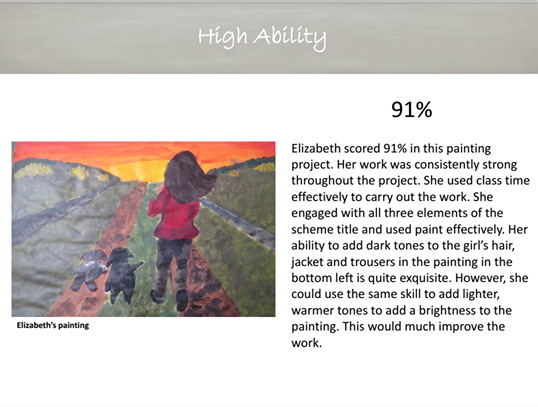Teaching and Learning
Teaching Strategies
A variety of teaching strategies and how they support student learning are discussed in the rationale in the link below. The strategies are applied to a painting scheme where students had to show an element of care that occurs between people and their animals. This scheme was carried out with a group of second-year students. The painting scheme aimed to teach students about composition, colour and texture. Teacher exposition was used to model knowledge to students and give instructions. The most predominant strategy used was heuristic experimentation for students where they had a chance to problem-solve independently to discover what it is like to be an artist. Teacher demonstration and questioning were carried out during the scheme as students learn well through visuals and auditory means.
Differentiation
The second-year group were a mixed ability class. It was important to allocate think time when questioning students and target students with both lower and higher order questioning. Students had a choice within the subject matter, i.e., they could choose the animal they wanted. It is important to differentiate for students in this means to reduce the behaviour issues.
Literacy and Numeracy
-
It is important to continuously repeat keywords (e.g. composition, atmosphere, texture) and check for student understanding. A board with the keywords written on it helps to jog students’ memories and they eventually start to use them in application to their paintings during discussion in reviews. When vocabulary is embedded in a lesson, it is a sign of true learning.
-
Students develop strong practical numeracy skills during painting schemes. When gridding is applied, students have to measure dimensions and carry out mathematical tasks to translate and compose the imagery onto the ground for painting. Students also strengthen their problem-solving skills when experimenting with the application of paint and colour-mixing.
Classroom Management
I have learned that is pivotal to have a strong classroom management strategy. The teacher must monitor the classroom, give clear instructions and create several tasks to keep student attention and engagement. Providing students with positive reinforcement through feedback and direction as well as specific praise creates a high morale and positive relationships in the classroom.
In the subsequent slides, is a Combined Learning Artefact project, which was
carried out in reflection to the rationale and the scheme. It is divided into four
main parts: Planning
Teaching
Assessment
Reflecting
Planning









Teaching









Assessment









Reflecting








